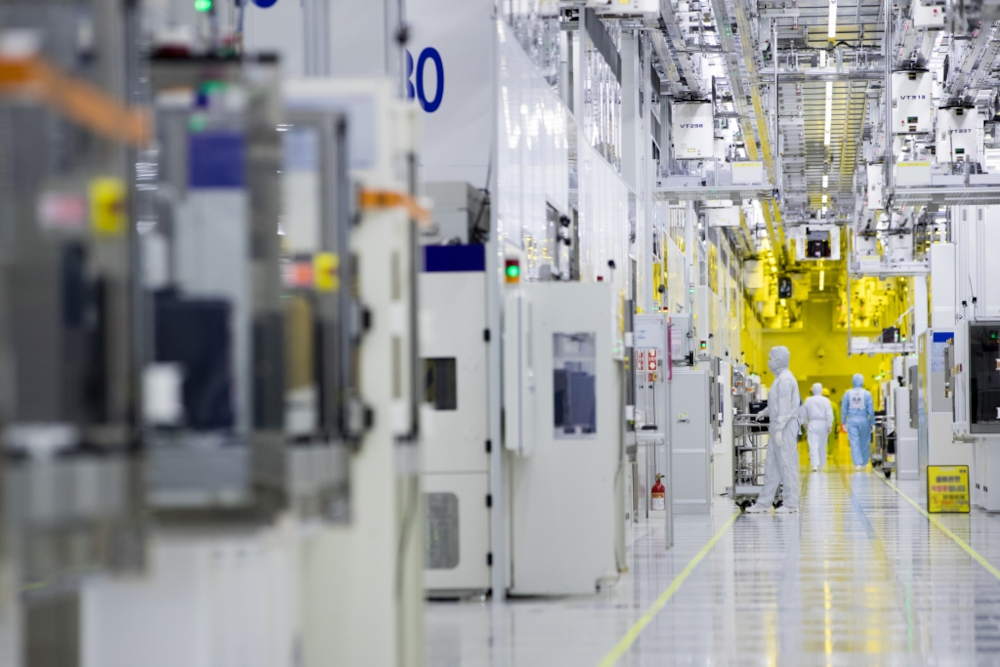[A cleanroom at Samsung’s fabrication unit in South Korea. With advanced chips built at nanometre scale, even a particle just a few cubic micrometres wide can damage circuits. Photo from Samsung]
In 1962, President Kennedy imposed a trade embargo on Cuba, attempting to strangle Castro's regime economically. It was a simpler time—sugar, cigars, and rum could be sourced elsewhere. Six decades later, everything has changed.
On October 13, 2025, the Dutch government moved to take control of Nexperia, a Chinese-owned chipmaker. China has recently banned the export of materials that go into everything from a mobile to an electric vehicle to a drone. When politicians brandish tariffs as economic weapons against high-tech imports, they're wielding a Cold War-era cudgel in an age of quantum computing and 3-nanometer chips.
This is because of what might be called the ‘quantum entanglement of global manufacturing’—and no sector is more deeply enmeshed than the manufacture of computer chips.
The Island That Holds the World Hostage
Taiwan Semiconductor Manufacturing Company (TSMC) operates from an island roughly the size of Maryland. Yet this single company produces over 90% of the world's most advanced chips—the silicon brains powering everything from your iPhone to F-35 fighter jets. If TSMC's fabrication plants went dark tomorrow, the global economy would first dodder in the dark and later collapse.
Apple, NVIDIA, AMD, Qualcomm, and virtually every major tech company depends on TSMC's specialized manufacturing. As Guardians of the Galaxy put it, "There is no Plan B. There is barely a Plan A-minus."
TSMC pioneered what's called the "pure-play" foundry model in the 1980s—they manufacture chips designed by others but design none themselves. This intense specialization allowed them to pour tens of billions of dollars and their best engineering talent into manufacturing perfection. The result? A technological moat so wide that competitors would need a decade and hundreds of billions of dollars just to approach the shore.
The Web That Cannot Be Unwoven
Here's where tariff enthusiasts encounter reality's sharp edges.
Video Explainer | Inside the Chip Web: How the Global Semiconductor Ecosystem Works
The world of semiconductors isn’t just about silicon and fabs — it’s a complex, interdependent network of design, materials, machinery and talent stretching across continents. This short video walks you through just how fragile, interlinked, and essential that web has become. (Play time: ~ 3.45 mins)
A modern semiconductor is born from a global web built over decades—each node representing billions in investment and deep, often monopolistic, expertise.
Consider the journey of a single advanced chip:
The design begins in California's Silicon Valley, where fabless companies like NVIDIA employ thousands of engineers using specialized Electronic Design Automation (EDA) software—virtually all produced by three American companies: Synopsys Inc., Cadence Design Systems, and Siemens EDA (formerly Mentor Graphics). This software represents a quiet American monopoly that nobody talks about because it's so complete.
The design draws on ARM Holdings in the UK, which licenses the architecture inside almost every smartphone chip.
Manufacturing requires machines that cost $150 million each and are produced by ASML (Advanced Semiconductor Materials Lithography), the Dutch company. These Extreme Ultraviolet (EUV) lithography systems are arguably the most complex machines humanity has ever mass-produced. ASML holds a monopoly by sheer technological supremacy—its machines depend on optics from Zeiss in Germany, lasers from California, and parts from hundreds of suppliers worldwide.
The fabrication happens primarily in Taiwan at TSMC, with some production in South Korea at Samsung, and legacy chips in China. A single advanced fab costs $20 billion and demands thousands of engineers working at atomic precision.
The materials are global. Ultra-pure silicon wafers from Japan, photoresist chemicals from Tokyo Ohka Kogyo, over 100 specialty gases and chemicals from suppliers in Germany, Taiwan, and South Korea. The purity requirements are staggering—we're talking about 99.9999999% pure materials, where a few rogue atoms can destroy a billion-dollar production run.
The packaging and testing increasingly happens in Taiwan, Malaysia, Vietnam, and China—with advanced packaging (chiplets, 3D stacking) becoming as technologically sophisticated as the chip manufacturing itself.
As a semiconductor executive told me: “People think we make chips in factories. We don't. We conduct symphony orchestras where every instrument is on a different continent, and if the piccoloist in Malaysia misses a note, the entire performance in Taiwan fails.”
Why Tariffs Are Bringing Swords to a Drone Fight
Tariffs are hammers built for an age of washing machines and steel—not for an industry where every chip is a cathedral of precision.
Tariffs assume you can switch suppliers. You can’t. No American firm makes TSMC’s 3-nanometer chips. Intel is years behind. GlobalFoundries gave up on leading-edge manufacturing entirely. Building the capability isn't a matter of writing cheques; it's a matter of replicating an entire ecosystem of specialized equipment, materials, and—crucially—human expertise that took decades to develop.
Tariffs on Dutch or Japanese chip equipment only make American fabs costlier—a self-inflicted tax on your own industry. Intel now pays more for ASML machines, making Intel less globally competitive. You've fired an economic weapon backwards.
Tariffs move in months; chip ecosystems evolve over decades. The mismatch is fatal. The U.S. CHIPS Act is pouring $52 billion into domestic manufacturing. TSMC’s Arizona fabs, which started production in 2024, won’t replace Taiwan—they’ll supplement it, providing “strategic capacity” for critical applications if Taiwan becomes inaccessible. Samsung is investing in Texas. But these facilities won't reach full production until 2025-2027, and even then, they'll produce perhaps 20% of what Asia produces. Meanwhile, TSMC had to convince thousands of Taiwanese engineers to relocate to Arizona, offering massive bonuses and creating Mandarin-speaking schools for their children. You cannot tariff this bottleneck away.
The talent trap is perhaps least understood. Advanced semiconductor manufacturing isn't just capital-intensive; it's expertise-intensive. TSMC's competitive advantage isn't just their buildings—it's the institutional knowledge embedded in their engineers who've debugged thousands of production runs, who instinctively know when a process is drifting, who've built mental models of systems with billions of variables. This knowledge exists in specific places: Taiwan's Hsinchu Science Park, South Korea's semiconductor clusters, small pockets in Arizona and Oregon. You cannot train this expertise with a four-year degree. It takes a career.
The Geopolitical Trap
Here's the paradox that keeps national security advisors awake: The very entanglement that makes tariffs ineffective is also a massive vulnerability.
China knows it depends on Taiwan for advanced chips. Taiwan knows it depends on ASML for manufacturing equipment. ASML knows it depends on customers worldwide. The U.S. knows it depends on all of them. This mutual reliance was supposed to be stabilizing—the “Golden Arches theory” of geopolitics applied to semiconductors. Countries enmeshed in critical supply chains don't go to war because war would be mutually catastrophic.
But that same web of reliance also creates fragility. A Chinese blockade of Taiwan wouldn't just be a military crisis—it would trigger the instant cessation of advanced chip production globally. Auto manufacturers would shut down within weeks. Data centers couldn't replace failed servers. Smartphone production would halt. The strategic calculation becomes: Who can endure economic pain longer?
This is why we see what might be called "strategic tariffs"—not designed to actually move supply chains, but to signal seriousness, to incentivize partial diversification, to create bargaining chips (pun intended) in larger negotiations. The Biden administration's restrictions on chip exports to China weren't primarily economic—they were strategic, an attempt to slow China's military and AI development even at significant cost to American companies.
The Future: Controlled Redundancy, Not Decoupling
The semiconductor industry is slowly, expensively building redundancy without abandoning the specialization that made it efficient. Think of it as adding airbags to a Formula One car—not to slow it down, but to make sure the crash doesn’t kill everyone.
TSMC's Arizona fabs won't replace Taiwan—they'll supplement it, providing “strategic capacity” for critical applications if Taiwan becomes inaccessible. Samsung's investments in Texas serve similar purposes. Intel's attempt to regain manufacturing leadership (after falling behind in the 2010s) is now explicitly framed as “geopolitical necessity” as much as business strategy. Which is corporate-speak for: “The Pentagon is deeply concerned, and we'd like more subsidies, please.”
But don't mistake this for decoupling. The new fabs in America will still use ASML’s Dutch machines, Japanese materials, and EDA software from California. They’ll still employ thousands of Asian engineers on work visas because the expertise concentration cannot be rapidly replicated. The web is being reinforced with redundant strands, not untangled. It’s diversification theater—real enough to matter in a crisis, not real enough to survive without the original system.
The industry’s own lobbying group, the Semiconductor Industry Association, inadvertently captured this impossibility perfectly in August 2025, when President John Neuffer responded to new tariff proposals by noting that the industry is investing $630 billion across 28 states, and then gently reminded policymakers: “To sustain these investments, America must be a cost-competitive location.” Translation: “If you make our supply chain too expensive with tariffs, we’ll take our $630 billion—and our extremely expensive insurance policy—somewhere else.”
India, too, is trying to find a foothold in this web.
The government has announced multi-billion-dollar incentives to attract chip manufacturing, and firms such as Micron, ISMC Analog, and Tata Electronics have signaled intent. But India’s semiconductor journey begins where others already have a 30-year head start. Its real strength today lies not in fabrication but in design talent—tens of thousands of engineers powering global chip-design centres in Bengaluru, Hyderabad, and Noida. If India can turn that design edge into a credible role across the value chain—from packaging and testing, to advanced materials—it could become a stabilizing node in an otherwise fragile system.
And yet, for all this redundancy, the system remains what it has always been—a web of mutual dependence with no safe exits.
The Lesson: Welcome to Weaponized Interdependence
The semiconductor industry reveals an uncomfortable truth for the age of renewed nationalism and trade wars: hyper-specialization created efficiencies so deep, what scholars now call ‘weaponized interdependence’—a system built on mutual vulnerability. Each nation has a chokepoint it can squeeze—America controls design tools, the Netherlands controls lithography, Taiwan controls fabrication, Japan controls materials, China controls rare earth processing. Everyone has a hand on someone else's throat.
Chris Miller, author of Chip War and a leading historian of technology, describes the current state as “weaponized interdependence”—a system where economic integration has become so deep that the connections themselves are the weapons. But here’s the twist: in such a system of mutual entanglement, using your weapon destroys your own economy as surely as your adversary’s.
The world discovered something profound in building the global semiconductor industry: some technologies are so complex, so capital-intensive, and so dependent on concentrated expertise that they’re effectively immune to the traditional tools of economic statecraft. We can regulate them, restrict them, subsidize them, but we cannot easily relocate them without accepting technological regression that would make the 1970s look advanced.
Governments are learning an expensive lesson: in the age of silicon, interdependence isn’t a policy you can reverse with taxes—it’s a physical reality etched into billions of transistors and decades of know-how.
In the end, the tariff isn’t a weapon. It’s a mirror—reflecting just how tightly bound our economies and vulnerabilities have become.


